Search Results for: star wars week
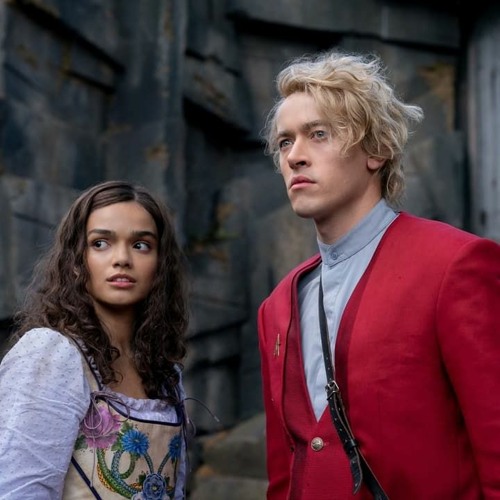
Can it be possible?
Is the Hunger Games sequel actually good?
The film made 44 million on its opening weekend, which was considered a proper fail. But it made 28 million on its second weekend, only a 35% drop. For comparison’s sake, another sequel, John Wick 4, dropped 60%. Even Guardians of the Galaxy 3 dropped 47%.
This would seem to indicate that Songbirds and Snakes is getting great word of mouth. But I have a theory here. And it’s a two-pronged theory. I’ll let you guys decide if I’m descending more into the conspiracy zone.
Part 1 is that Taylor Swift has a cameo in the film as an extra. With the Swiftie Army in full assemblage, I’m betting that a bunch of girls came to this film to grab a glimpse, a tiny visual nugget, of the famous singer.
Part 2 – and the bigger reason – is that I think everyone’s sick of Disney. I’ll get into this more in a second. But anything that doesn’t look like Disney right now, people are interested in. They don’t want superheroes. They don’t want space men. They don’t want live mermaids. They want something that feels new.
It’s Hollywood’s biggest blind spot. They milk the cow long after it stops making milk. They can’t help themselves. To be fair, Lionsgate, the studio behind Songbirds and Snakes, would probably do the same. They just don’t have any of those fancy properties. So they’re forced to make stuff that’s different. And, although it took a while to finally start digging into that Disney pie, apparently Thanksgiving was the breaking point for America. They’re finally telling you they want something new with their hard-earned money.
Speaking of Hollywood they’re, once again, using their tricky box office reporting practices to sell a not-so-accurate picture of Napoleon’s debut. Everyone’s touting this 32.5 million dollar opening weekend for the film, a significant box office upgrade over its primary Oscar competition, Killers of the Flower Moon, which only made 22 million its opening weekend. Until you realize they’re using the 5-day holiday take rather than the 3-day take. Napoleon only made 20 million dollars for the 3-day, less than Killers did.
I suppose you want the biggest numbers possible behind your opening weekend but everyone knows that these movies aren’t built to be giant blockbusters. Anything adult-skewing is lucky to hit 30 million on opening weekend. 20+ million is still quite good. Oppenheimer skewed everything but it was an outlier. It probably made 15 million alone that first weekend on dads being forced to take their wives and daughters to Barbie. An atomic bomb was the perfect escape route, lest they be permanently ported into Barbie’s perpetually pink universe.
I tried to get my family to come see the movie with me on Friday but there wasn’t a taker in the bunch. It was an indictment on what streaming has done to the movie-going public. The general consensus seemed to be, “Why go through all that when we can just watch something here on one of our eight streaming services?”
To be fair, it’s a hard point to argue against. Jaqouin Phoenix is one of the five weirdest people on the planet, a total wild card. Who’s to say we aren’t stumbling into another Beau is Afraid as opposed to another Joker?
Maybe the biggest surprise of the weekend is Disney’s Wish. Disney should own any holiday weekend it debuts a movie in. Especially going up against adult fare. Yet Wish found itself the stray coin, far removed from the fountain it was hurled towards—a toss so errant that the U.S. Treasury resolved to expunge its existence from the annals of the mint.
A lot of people are saying that Wish is the culmination of the 2016-2022 Disney era strategy of prioritizing social change over stories that people actually want to see. From Turning Red to Strange World to The Little Mermaid. I think the answer’s a lot simpler: NOBODY KNOWS WHAT THE F*&% THIS MOVIE IS ABOUT.
I actually liked the trailer. The villain is hateable. The lead is likable. The music sounded great. The secondary characters were funny. But it just goes to show that if you don’t get your concept right, nothing else matters. You’re building a house on a foundation of sandpaper.
Either way, Disney’s been playing with fire lately and they’ve turned their head long enough to miss the fact that the fire is now a raging inferno. Marvel is in trouble. Star Wars is in trouble. Pixar is in trouble. Disney Animation is in trouble. Disney animation-to-live-action is in trouble.
I remember writing an article six years ago about how every one of these divisions was churning out record-breaking hits. For each one of them to now be as abysmal as they are is kind of shocking. There are a lot of areas you can blame here but, whatever the reason is, they need to figure it out fast. Cause even Disney can’t keep losing 200+ million dollars a movie.
They don’t even have a strategy to get out of this. Their next Star Wars movie is being directed by the director of the least watched Marvel show Disney has ever made and starring the most average character Star Wars has ever created – Rey. And Marvel is expecting to make an Avengers film in 2025? They haven’t even filled in the empty slots that the last Avengers left. The whole reason that the Avengers worked was because it was carefully built up to over 8 years. Maybe they can squeeze Deadpool in there. He’s the only superhero that has a chance of making that interesting.
But they’re in trouble, man.
To finish off on a positive note, I keep running into people who tell me All The Light We Cannot See – the Netflix adaptation of the super bestselling novel – is awesome. They don’t even say, “It’s pretty good.” Or “It’s good.” They literally say “It’s amazing.” Or, “It’s one of the best shows I’ve seen this year.” I have been ignoring all these recommendations because it’s unheard of that I’ll like something that gets in the 20s for an RT score (All The Light has a 28% currently). But I can’t ignore this anymore. I have to watch this show.
Are you guys going to watch it with me?
I need some backup.
Feel free to opine on this weekend’s box office. And remember that Thursday we have a Logline Showdown. So make sure you enter!
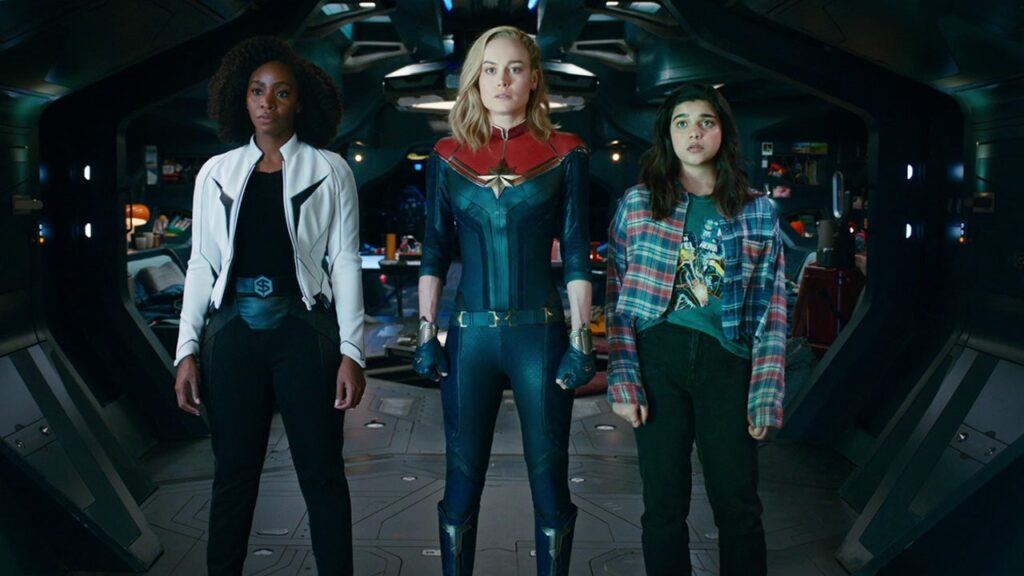
It’s been many moons since I’ve last been enamored by a script. Or a movie, for that matter. It’s led me to question what the issue is. Is it everybody else? Do people simply not know how to write anymore? Or is it me? Have my standards become too high?
I’ll tell you what I’m scared of. I’m scared of becoming that Scriptshadow commenter who hates every movie. If I can no longer enjoy the movies I watch or the screenplays I read, then there’s no incentive for me to continue doing this. I’m not interested in having a website that craps on everybody. I want to spread LOVE! Not be a hater-potater.
And yet Hollywood is doing everything in its power to lure me into a hate cocoon. I commend the Marvel marketing team for their Herculean effort to convince people that The Marvels is actually good. I’m assuming they sent Chris Hemsworth out to spend a day with every critic who gave this film a fresh score on Rotten Tomatotes. But come on, Marvel has known for a year that they’re dealing the cinematic equivlanet of fentynal. It’s insulting to sell us that this movie is actually watchable.
Then we get this new Ghostbusters trailer. What is going on here?? It’s a movie about an ice villain??? Did they accidentally swap with one of Marvel’s scripts? We’ll find out a year from now when Marvel releases Ghost Thor: Who Ya Gonna Call.
I haven’t even enjoyed the Star Wars offerings. You know what’s sad (or awesome, depending on your point of view0? One of the ways I wind down is watching Youtube videos of people watching the original Star Wars for the first time. It’s so addictive seeing them experience this wondorous perfect movie for the first time ever. And every time, without fail, they always get excited at the right moments. They laugh in all the right places. In a way, it’s like I’m watching Star Wars for the first time as well.
But these days, the serious Star Wars TV shows (Andor) don’t work for me. The silly ones (Ahsoka) don’t work for me. That Madalorian episode with Lizzo and Jack Black very well may have heisted my soul and sold it on ebay for Yoda earings.
I haven’t even been able to enjoy the Oscar-hopefuls – Oppenheimer, Killers of the Flower Moon, Barbie – which are supposed to be the projects that actually put time and effort into their screenplays.
So I think about this question a lot. Are my standards for screenwriting so high, at this point, that they can no longer be met? I’m biased but I don’t think they are. Still, several things have happened in the industry that have really hurt screenwriting in the past decade.
One of the issues is we don’t have that central screenwriting teacher anymore. In the 80s and 90s, it was Syd Field. In the 2000s, it was Blake Snyder. But once the internet popped up, writers stopped reading complete books on how to write screenplays and, instead, piecemealed their screenwriting education together through online screenwriting articles. So they know certain things (add conflict to your dialogue!) yet are totally clueless to others (how to build a compelling second act).
In addition to this, feature screenwriting moved away from singular protagonists trying to achieve a goal – the purest form of storytelling – to the “Marvel Ensemble” model where the writer is juggling 10 different protagonists and their subsequent storylines. Which isn’t normal! That’s not a typical story anyone would tell.
Then you have the rise of golden era television, with 1000 shows on TV, so that’s where all the writers went. And what does television promote? The never-ending story. There is no climax, which teaches screenwriters terrible habits. Cause if you don’t have to end your story, you never have to think about where your characters are going. And when those writers dip their toes back in the feature space, they bring that issue with them. Their narratives seem flighty and aimless because that’s the only kind of story they’ve had to write!
In other words, NOBODY KNOWS THE BASICS ANYMORE. They’re just making sh*t up as they go along. Yesterday’s script, which barely BARELY got a “worth the read,” is a good example. The theme of the script is messiness. The messier the better. That’s not good screenwriting. Good screenwriting requires focus and structure and planning.
So what I thought I’d do as we head into the weekend is remind writers of the basics. It’s not that hard. It really isn’t. But if you’ve never learned these things, then you’re probably writing a lot of weak-sauce material.
1 – Give us a likable character. Introduce your character in a way where we like him or her. Or, at the very least, sympathize with them. For example, if a woman’s husband of 20 years just blindsided her with divorce papers, we will sympathize with her. The reason this is so important is because nothing you do after your protagonist’s introduction will matter if we’re not rooting for them.
2 – Create a problem. A story cannot start until there’s a problem. This is the thing that jolts our protagonist into action. Think about it. If there’s nothing that forces your character to do anything, then they won’t do anything! You don’t have a movie if your main character isn’t doing anything. In one of my favorite movies from recent years, Parasite, the “problem” is very simple. The family is broke. They have no money. They need a solution.
3 – The problem introduces the goal. Once you introduce a problem into your hero’s life, you’ve created the all important GOAL. Cause now your hero has to SOLVE THE PROBLEM. And needing to solve a problem is a goal. To use Parasite as an example again, the goal is to take over the rich family’s home.
4 – The goal gives you your stakes. The reason the goal is so important is because it needs to power you through your second act. If the goal is minor or flimsy, it won’t be able to achieve this. This is where STAKES come in. We have to feel like everything is on the line for your hero. If you succeed, you get everything. If you fail, you lose everything. In other words, the bigger the problem, the more impressive the goal, which means higher stakes, which means you have more power to drive the second act. And just to remind you, NONE OF THIS MATTERS IF WE DON’T LIKE YOUR HERO. Which is why getting number 1 right is so important.
5 – Throw obstacles in front of the goal – A goal, in and of itself, is boring. Where the excitement happens is when that goal is challenged. So you want to think of your second act as the “Goal-Challenging Section.” You want to throw a bunch of things at the hero so it’s hard for them to achieve the goal. The harder it is, the more we’ll enjoy ourselves. Cause think about it: how exciting is it to watch someone try to achieve their goal with only minor pushback? To use Parasite as an example again, the midpoint has this crazy psycho dude secretly living in the basement. Talk about a challenge. How do you take over a house when you have this other guy already living there?
6 – A challenged goal makes your hero stronger – The bonus of challenging your hero in their pursuit of a goal is that it BUILDS CHARACTER every time they overcome one of these challenges. And each time that happens, assuming you got the number 1 rule right, we will like your character even more. Cause we like people who take on obstacles and overcome them. You know your second act is working when our love for your protagonist is growing.
7 – Endings aren’t as hard as you think – A good ending is less about some inventive never-before-seen plot twist and more about your hero facing their flaw head on and overcoming it. The endings that stick with us have some sort of emotional catharsis. Again, you got to get number one right or NOTHING YOU DO in the third act will matter. But, if we like your hero, and we’ve seen them struggle throughout the second act, and they overcome their flaw in the climax (Rocky overcomes his self-doubt to go the distance in the championship match), that goosebump-laced rush will shoot through the reader. Always try and think of your climax as an emotional catharsis and not as the final piece to a plot puzzle.
These tips don’t cover everything, obviously. You still have to surprise us, make interesting creative choices, write good dialogue, have a couple of stand-out characters besides your hero. You’d also like to execute your story with a unique voice or a fresh angle in order to stand out from the pack. But if you follow the above seven tips, it’s really hard NOT to write a good screenplay.
As for whether I’m still capable of being impressed anymore, I already have 10 movies that are going to make my Best Movies of 2023 list. I already have 10 scripts that are going to make my Best Scripts of 2023 list. That’s 20 stories right there. Should I really be asking for more than that in one year? I don’t think so. That’s plenty. I guess I was hoping for more stuff to blow me away this year. But maybe that’ll come in 2024.
I offer feature screenplay and pilot script consultations – the best notes in the business. If you mention this article, I will give you a $150 discount. Your script doesn’t have to be ready yet to secure the discount. You can send it in at a later date. Just e-mail me at Carsonreeves1@gmail.com. Can’t wait to read your script!
Genre: Biopic/Historical
Premise: The story of the development of the atomic bomb by its creator, J Robert Oppenheimer.
About: While it may not be getting Barbie-level love, Oppenheimer still somehow pulled in 80 million dollars this weekend, putting it on pace to become the biggest non-musical biopic ever. Believe it or not, writer Christopher Nolan wrote the Oppenheimer script in the first person! He also finished the script in a matter of months (not surprising after seeing the finished product).
Writers: Christopher Nolan (based on the book by Kai Bird and Martin Sherwin)
Details: 3 hours long

The computer seat layout for my AMC showing of Oppenheimer showed a 98% full capacity. But when I got into the theater, it was only 40% full. Looks like this fake seat-buying scam is becoming an epidemic!
But the important thing is that I finally got into the theater and saw Christopher Nolan’s Oppenheimer. Yahoo!
How was it?
Let’s find out.
I’m going to present the plot summary the way I saw it. I’m not going to look up anything online to help me because I want the movie to do the work on its own. If I got something wrong, it was the movie’s fault for not making it clear enough.
Oppenheimer starts in the late 30s when a clumsy young Robert Oppenheimer begins teaching a new form of physics – quantum physics. When World War 2 starts, a guy named Leslie Groves (Matt Damon) approaches Oppenheimer to start the Manhattan Project, which is the building of the first atomic bomb.
We then start jumping between three other storylines. One is set in the future (aka, present) where a man named Lewis Strauss (Robert Downey Jr.) is testifying in front of Congress about – I think – whether the building of the bomb was the right thing to do and, also, whether Oppenheimer had been too sympathetic with the Russians during that time.
A third timeline has Oppenheimer, himself, being interrogated by a separate group of people about a couple of his Russian friends.
A fourth timeline seems to be embedded between these sections – although it’s unclear where – where we see Oppenheimer fall for a co-worker who’s a bit of a crazy pants (Florence Pugh). Oppenheimer eventually leaves her for a woman named Kitty (Emily Blunt).
I was never entirely clear on when everything took place. I was most comfortable in the Manhattan Project section because it was the only section where I was clear on what was happening. And it definitely was the best section.
It wasn’t as much of a race against time as I was hoping for. But the narrative was, at least, pushing forward. And when they finally do build the bomb and send it off to the military who then blow up Hiroshima, we never see any of that. We, instead, stay with Oppenheimer, who has very complex feelings about this bomb he built.
We then spend the last 45 minutes of the film in some political bugaboo plot where Oppenheimer and Strauss battle it out over issues that nobody who didn’t read the Oppenheimer biography understood. The end.
I’ve never questioned Christopher Nolan’s ability as a filmmaker. He may be the best pure filmmaker on the planet, his only competition, David Fincher.
Nolan clearly went into this thing wanting to catch a feeling. The feeling of what it was like at that time working on the most important project humanity had ever worked on.
And the way he went about it was… okay, I guess.
As per usual, Nolan is determined to prove he’s no ordinary storyteller. He laughs in the face of structure, eschewing 3 acts for this topsy-turvy maze of cross-cutting between the past, the semi-past, and the present. Taking a chapter out of Sorkin’s handbook, we get this “courtroom” present plotline that helps us look back at the building of the bomb, similar to what Sorkin did with The Social Network.
Nolan’s approach doesn’t have a rhyme or reason to it other than to keep us on our toes in hopes that we don’t get bored by watching 10,000 characters have 5000 conversations in medium-sized government rooms.
Indeed, I spent much of the running time trying to keep up with all the dots I was tasked with connecting. That kept my mind active enough that I wasn’t bored. Yet I was constantly asking myself what this was all about.
The only driving force behind the narrative was the construction of the bomb itself. Much like how we knew the ship was going to sink in Titanic, we know the bomb will be completed and blown up in Oppenheimer. Except in Titanic, we were with the people who were going to die, making the proceedings a lot more personal. Here, we never meet any of the people who are going to die by the bomb’s hand, eating into the drama considerably.
One of the most disappointing choices Nolan makes is not showing us the bomb exploding in Japan. And I know exactly why he didn’t show us. Because he rationalized: “Oppenheimer didn’t get to see it. So why should we?” It is one of the weaknesses that makes Nolan such a spotty writer. Everyone in the audience wanted to see that bomb go off. That’s what we’ve been waiting this whole movie for. And you’re not going to show us? It is the curse of the faux auteur. When you believe in yourself so highly as an artist, you deliberately make your audience suffer. It’s bad form.
Instead, Nolan seems way more interested in the less compelling storyline of “Is Oppenheimer sympathetic to communism or not?” The audience’s collective response to that question is, “Who the hell cares?” Nobody!
Oppenheimer ended the war. That’s what we care about. If he had a few Russian friends along the way, what does that matter? HE STILL ENDED THE WAR. He still won the war for the United States and the Allies. Why are we quibbling over his drinking buddies?
Nolan doubles-down, forcing the audience to stay in their seats a full 45 minutes after the movie has ended (the bomb has been dropped and Japan has surrendered) so that we can wonder if one of the Russians on the Manhattan Project spied and took all of Oppenheimer’s nuclear secrets, resulting in the Russians learning how to build nuclear bombs and starting an arms race.
Why do we not care about this? Because WE KNOW NOTHING COMES OF IT! We’re all still here. No nuclear wars have happened. So who cares? This is the most pointless plotline to focus on. Not to mention, Russia would’ve figured out how to build nuclear weapons regardless of whether there was a spy or not. The movie makes it clear early on that several countries were making rapid progress on building atomic bombs.
Because Nolan doesn’t know how to write, he missed the much better story option of leaning into the thriller aspects of this story. You had the most natural ticking time bomb ever (a LITERAL ticking time bomb). We have to build this bomb or hundreds of thousands more people will die in this drawn out war with the Japanese. Add the threat of someone else building a bomb before we did and you have yourself a much more effective narrative. Think The Imitation Game, which executed its war story much better.
But the biggest stumble by the brick and mortar director was his final act, if you can call it that. It went on and on and on and on. Rocky’s already won the goddamned fight! Find Adrian, kiss her, then GET THE F OUT! You’re done. The movie’s over.
Nope. Not Nolan. The man’s confused writer mind thought the better route would be to climax then keep you around for 45 minutes of pillow talk. Pillow talk is an apt metaphor, as half the things you say post-coital are mumbling incoherence. There was some beef between Oppenheimer and Robert Downey Jr.’s character that was the worst combination of super complex and completely irrelevant. WE DON’T CARE! WE CARED ABOUT THE FREAKING BOMB! Not whether two crybabies can say sorry to one another. Sheesh.
I’m sorry. I just can’t hold it in with this guy. He’s so talented in some respects but has this giant blind spot when it comes to his screenwriting. Oppenheimer reminds me a lot of Fincher’s “Mank.” Self-important. Pretentious. More about the director’s experience than the audience’s.
I’m not saying it doesn’t have anything to celebrate. Seeing all these great actors in one place was cool. Rami Malik, who lead his own billion dollar movie, is an extra in this film. That should give you an idea of the level of acting that was on display here.
Florence Pugh’s character was interesting. It provided the most human touch to the film.
And everything was beautiful to look at, of course.
But where’s the structure, man? Someone needs to sit Christopher Nolan down and explain to him that when you give the audience a climax, you’ve got about ten minutes max before they want to go home. Forcing them to stay at the party long after it was over was what turned this into a ‘not for me.’
[ ] What the hell did I just watch?
[x] wasn’t for me
[ ] worth the price of admission
[ ] impressive
[ ] genius
What I learned: You can’t have your cake and eat it too in screenwriting. According to Nolan, he was fascinated by delayed consequences for one’s actions. So he really wanted to know what effect this bomb had on Oppenheimer long after it’d been used. But he also wanted to show the building and use of the bomb. Those are two different stories. You can tell a story about one. You can tell a story about the other. But you can’t have your cake and eat it too. At least not in a movie. Maybe in a TV show. No one other than the most obsessed Nolan Stans are anything other than bored out of their minds during the final 45 minutes of this film because Nolan was trying to do two things that don’t complement each other.
Genre: Action
Premise: Ethan Hunt must battle his biggest threat yet – AI!
About: July was the summer’s biggest movie month. Indiana Jones, Barbie, Oppenheimer, Mission Impossible. Who was going to make it out alive? Who would fall? Cruise and McQuarrie’s latest, a labor of love that, at one point, had Cruise famously terrorizing his crew over broken Covid protocols, has finally arrived. It pulled in 56.2 million for the 3 day weekend and 80 million for the 5 day. A bit of a surprising choice at screenwriter for McQuarrie as he handpicked a guy named Erik Jendresen, who has not written anything of note. And now he’s got a Mission Impossible credit under his belt. Oh how your fortunes can change in this business. That big job that’s going to change your life is always right around the corner.
Writer: Erik Jendresen and Christopher McQuarrie (based on show by Bruce Geller)
Details: nearly 3 hours!
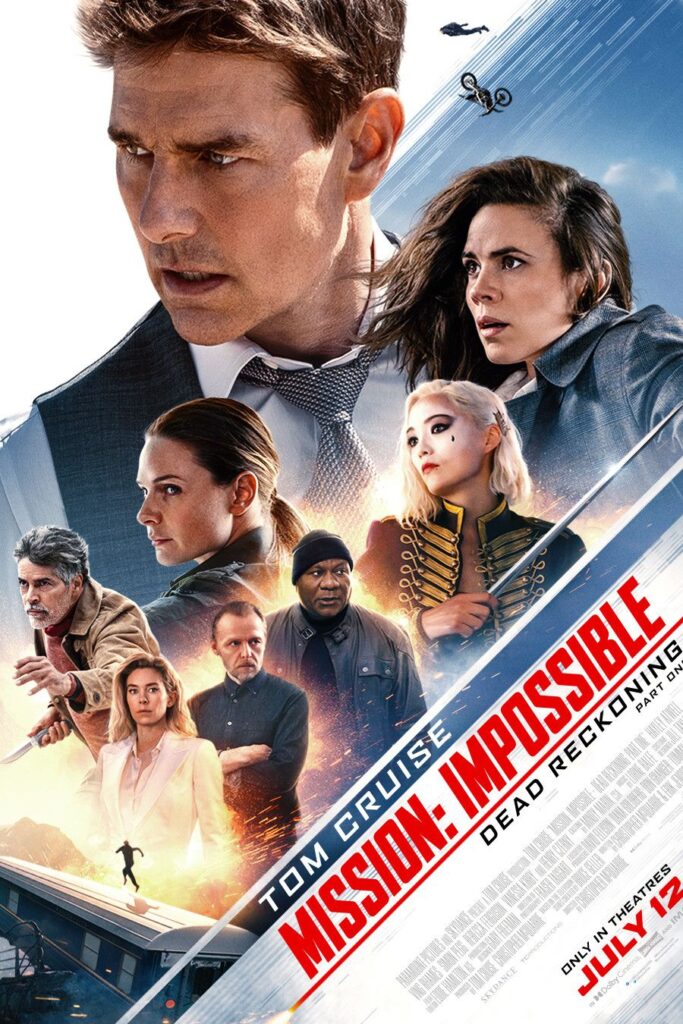
The Mission Impossible franchise continues to confuse the world with its box office reception. It’s never quite a hit but it’s never quite a bomb either. Still, I can’t help but feel like this latest iteration needed to do better in order to justify the continuation of the franchise.
56 million dollars for a weekend haul is not a great showing in 2023. Then again, defenders of the film will point out that Mission Impossible is not a domestic film. It’s a global film. And that’s where it will make its money.
I hope it does. Tom Cruise is basically the last actor opening movies all on his own. Once we lose that, it’s blue beetles all the way down!
Ethan Hunt is tasked with a mission (should he accept it). He’s got to get a key. This special key, which has two halves, has a mystery purpose. Nobody knows what it opens. Or even where the lock is that it opens. But that’s not of Ethan’s concern, he’s told by Recorded Voice Guy. Just get the key.
Meanwhile, the government is dealing with an increasingly unpredictable new AI that has, in their estimation, become sentient. The AI recently destroyed a Russian nuclear sub and an operating thesis is that the US could be next.
Enter Hunt, who has to get the second half of the key (he got the first half in the Arabian desert) from a mystery seller at an airport, all while being chased by the CIA. Things take a turn when a low-level pickpocket named Grace steals the other half of the key and now Ethan is forced to team up with her.
This begins a cat-and-mouse game between Ethan, Grace, the CIA, AI, and even Ethan’s own boss, which takes them across the globe and concludes on a runaway train. Along the way, Grace will have to decide if she wants to level up to become a true spy, and Ethan will have to… well… continue to achieve the impossible.

Midway through my Mission Impossible viewing, it occurred to me that I wasn’t sure what I actually look for in a Mission Impossible movie. When I watch a Star Wars movie, for example, I’m looking for insane imagination. I’m looking for new revelations into the lore. I’m looking for great characters. I’m looking for an awesome lightsaber battle. And I’m looking for two imaginative set pieces that blow me away.
I think with the modern-day Mission Impossibles – the ones written and directed by McQuarrie – I’m looking for a better written blockbuster than most (since McQuarrie started out as an Oscar-winning screenwriter). I’m looking for one really clever set piece. And I’m looking for one visually jaw-dropping set piece. I think that’s exactly what McQuarrie attempted to give us. So how did he fare in each department?
Let’s start with the script. The script is very much a Mission Impossible script. There’s the McGuffin of all McGuffins – a key that opens something. The key, is of course, split in half, which gives us an opportunity to extend the plot out (cause you’re looking for two things instead of one).
I’m not going to say it was a bad McGuffin. But one thing that really bothers me in McGuffins is when the McGuffin isn’t relevant. It’s just a means to get characters to run around. Ideally, you want your McGuffin to be more than a McGuffin. You want it to to matter! Like R2-D2. That McGuffin not only held the plans to the Death Star. But it was, in itself, a great character! These McGuffins today are just cool-looking keys?
But let’s move on to the big story gamble in the script – incorporating an AI villain. As others have pointed out, a faceless villain is risky because you don’t have a face for the audience to root against. You don’t have the potential for a true villain showdown. That’s not to say there aren’t bad guys in this film. But the bad guys here are not the *true* threat. The true threat is the AI and AI’s don’t have a personality to get you emotionally revved up about.
This was a surprising choice, I’m not going to lie. Stanley Kubrick proved 60 years ago that an AI could be a great villain, with HAL. I think McQuarrie’s plan was to terrify us by giving us a villain that didn’t have a personality OR a conscience. It was a giant cold piece of code. If something doesn’t have a personality, a conscience, an ability to be reasoned with – isn’t that the scariest villain of all?
Maybe.
But it sure didn’t help the film. This movie badly needed someone to root against. And I’ll tell you why. You’re using too generic of a movie formula to be able to skimp on personalities. Your characters are the only things that are going to make a movie like this stand out. Otherwise it’s just guns and chases.
Take John Wick 4, for example. That crazy fat club gangster guy was a true personality. He brought a larger-than-life personality to the proceedings which helped make up for the fact that it was a movie full of generic guns and fights. Same thing with the blind assassin. Personality.
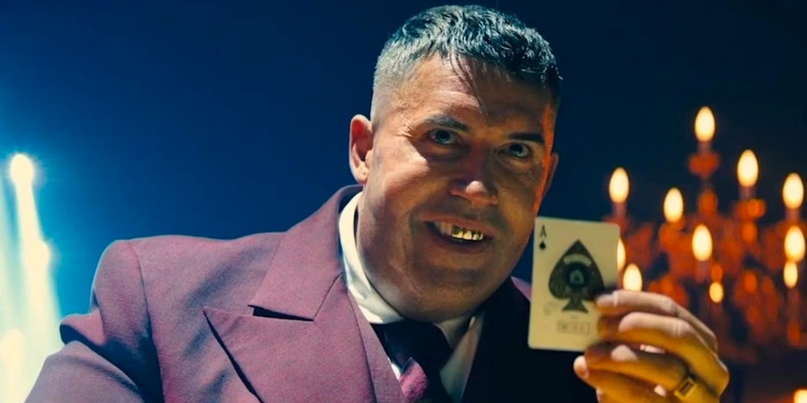
No personalities hurt Mission Impossible. You saw the culmination of this in that final train set piece. It was a good set piece but where was that emotional catharsis that comes from killing Hans Gruber, a guy we’d grown to detest? Not having that turned a potentially great sequence into one that was just “good.”
Overall, I was hoping for a more original story. This story was more of the Mission Impossible same – create a template for set-pieces and don’t give us a lick more. I’m such a story guy that I need more than that!
But let’s talk about those set pieces.
The two highlights were the airport set piece in the middle of the movie and the train set piece at the end.
The airport set piece is more of what I’m looking for in a set piece. Like I talked about on Thursday, I want that contained (we’re contained to an airport) clever set piece with a clear goal and a lot of obstacles and that’s exactly what we got.
BUT!
I think McQuarrie tried to do too much with it. There were some cool ideas here about hacking being used to change facial recognition so that the CIA attempting to locate Ethan Hunt results in them continually following the wrong guy. But once Haley Atwell’s, Grace, shows up and steals the key from the mark, things start getting confusing.
We’re dealing with Ethan trying to find a passenger with half the key. Ethan’s got the other half. He can’t buy the second half from this guy so he has to sell him his half instead and then get on a plane with him where he will, conceivably, steal the full key back at some point, after he’s gotten more information.
But Grace, a lowly pickpocket, takes the half-key from the mark instead and now Ethan’s following her. And, oh yeah, Benji is chasing down a nuclear bomb in the baggage claim that our AI villain somehow constructed that can only be disarmed by six riddles. The CIA is trying to locate everyone. With so many set piece storylines, I’d forgotten why we’d come here.
Guys.
Again.
The Langley white room hack scene from Mission Impossible 1 is such a simple scene. Why are we trying to make this sequence as elaborate as possible? For us to enjoy what’s happening, we must UNDERSTAND what’s happening. And the deeper you bury your set piece in storylines, the harder it is to keep track of things.
I would still say I enjoyed the scene, though. It was the most cat-and-mousy moment of the script and the cat and mouse stuff is what I enjoy most from the Action/Spy genre.
Moving on to the final train set piece.
The train set piece is preceded by the big stunt of the film, which is Tom Cruise jumping off a cliff on a motorcycle and then parachuting onto a moving train. The downside of promoting each Mission Impossible super stunt is that, by the time you see them, your expectations are sky high. So I was a little let down by the actual stunt itself.
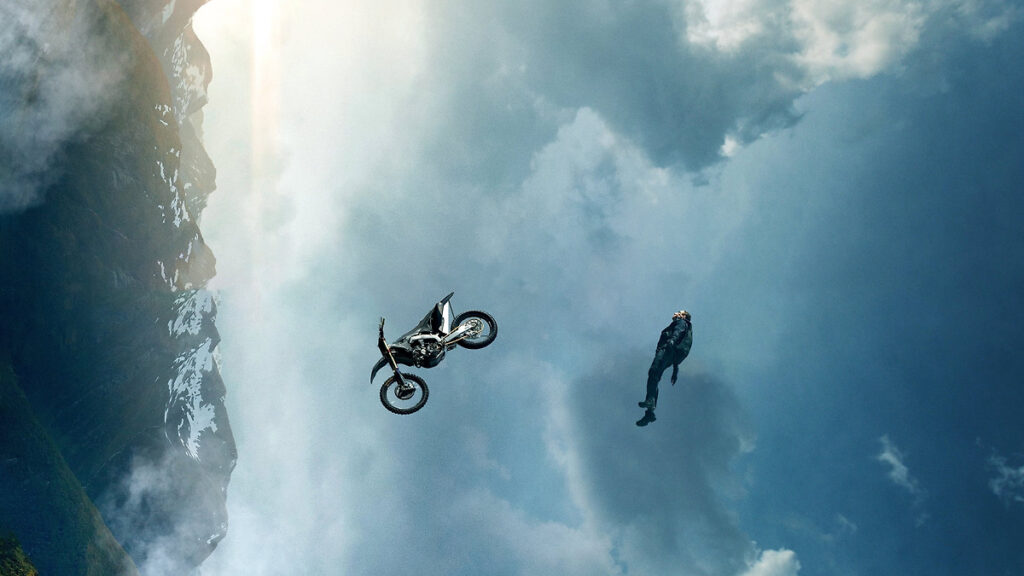
Cause I think the stunt only encapsulates jumping off the cliff and opening the parachute, right? It would’ve been REALLLLLLLLY cool if the stunt included that AND timing a parachute drift down and landing on a moving train.
I know! You’re saying, “Come on, Carson. You can’t actually expect them to do that.” Well, I kinda can. They’ve marketed Cruise as the super-stunter. So I’m expecting him to do impossible things. One quick hop off a cliff… I’m just not sure that’s enough for me.
Anyway, once we get onto the train, things get a lot more interesting. I definitely felt that this was the best sequence in the film. And kudos to McQuarrie because there have been a million train scenes already. So it’s hard to make one that stands out. I liked the use of the old school Mission Impossible masks in this sequence. And I definitely liked that train falling into the ravine one car at a time.
The biggest surprise of the movie for me was Hayley Atwell. She was fun. When I saw her first come on screen, I thought, “Wow, Hayley Atwell has had some work done. I guess she’s fallen into the Hollywood trap.” But then I realized, no, she just got in amazing shape! Which made her face look a lot more chiseled. It was quite motivating, to be honest. It shows how much you can change your look just by getting in shape. Put down those donuts, screenwriters!
And she had great chemistry with Tom Cruise, which is no doubt why they cast her. Plus, I liked the idea of bringing in a character who’s in way over their head and forcing them to keep up. Grace’s car chase scene was a cool sequence.
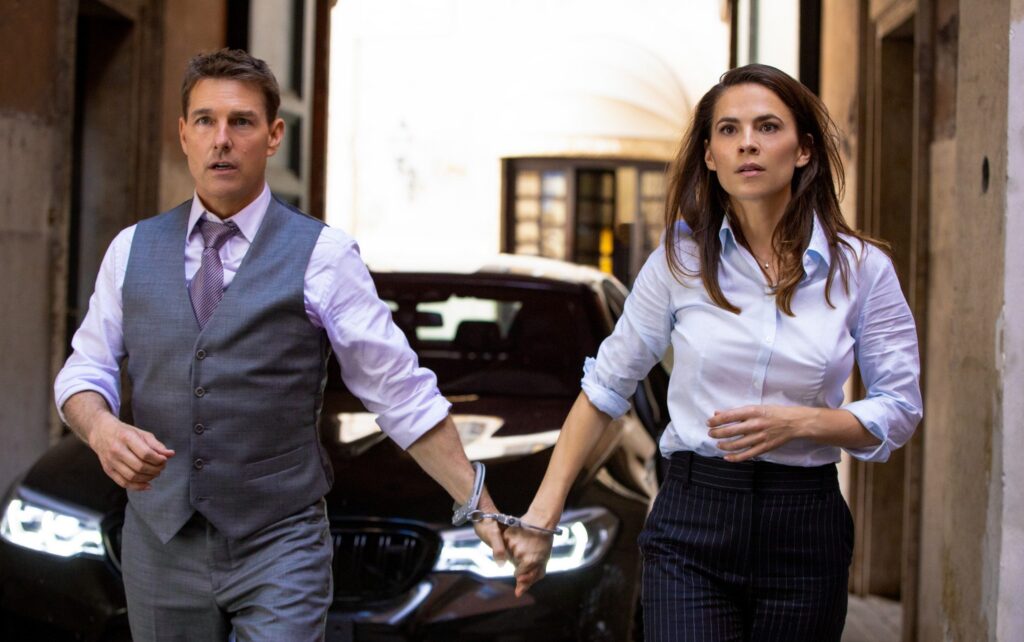
Speaking of that sequence! I’m always about finding new spins on car chases. Handcuffing Ethan and Grace together and throwing them into a car chase was a really creative twist. It forced them to have to be on certain sides of the car, which required the less competent driver (Grace) to drive, which was fun. And I loved when they tangled up their arms to allow Ethan to drive, creating a handicap for Ethan, which of course made the chase harder, which is always what you’re trying to do – make things harder for your characters.
But the villain, man! There’s no true villain here!
If you are going to make that commitment to AI as your villain, I would’ve liked them to commit to it. It seemed like AI was there for McQuarrie when he needed it and gone when it was inconvenient. For example, AI is, conceivably, always listening to us. If there’s an Alexa device in the room, or a computer, or a phone, AI can hear you. Cause AI is everywhere.
But there were plenty of scenes – such as the airport scene – where nobody was worried about that. Or remember that scene early in the movie where they’re debriefing everyone on AI and Hunt throws those green stink bombs. Why weren’t any of them worried about AI listening to them there?
If you want to truly TRULY explore the dangers of a dangerous AI, let’s get into the thick of things. Let’s not keep everything surface-level. Particularly because you’ve already got a faceless villain. You need to make up for that lack of personality somewhere.
When it comes to whether I endorse this movie or not, I’m on the fence. It’s fun. But it’s also generic. Cruise and Atwell are good. But nobody else really stands out. In the end I’d say it’s entertaining enough. I’m a sucker for a fun summer moviegoing experience and I think this satisfies that need.
[ ] What the hell did I just watch?
[ ] wasn’t for me
[x] worth the price of admission
[ ] impressive
[ ] genius
What I learned: More is rarely more. In screenwriting, less is usually more. There is no question in my mind that this movie becomes a lot better if they cut out the whole “obtain the first half of the key” stuff. Nobody cares about this Ilsa woman. The Arabian desert sequence was weak. If you nix that and, instead, start with them prepping for the airport exchange, this whole movie changes for the better. It feels faster. It MOVES faster. And I think with a zippier run-time people would leave the theater feeling more charged, which would improve word-of-mouth. As it stands, there’s no reason at all for this movie to be 3 hours.
And the power of containing your set pieces!
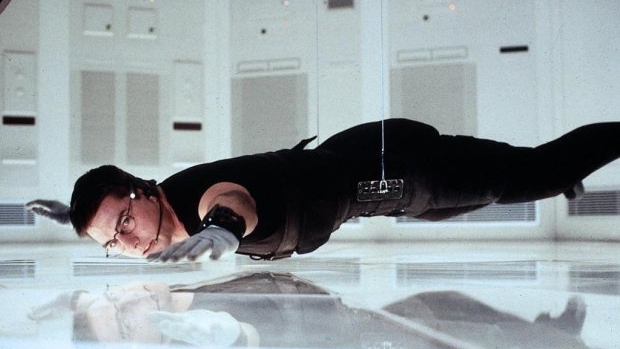
This weekend, I’ll be seeing the latest Mission Impossible movie. These movies have become known for their set-pieces, specifically the ones that Tom Cruise does himself. Tom Cruise scales a real skyscraper. Tom cruise HALO jumps out of a plane. Tom Cruise takes off on the side of another plane. Tom Cruise drives off a cliff on a motorcycle.
But Mission Impossible has plenty of other big set pieces, such as helicopters chasing trains through tunnels. Motorcycle racing through the hearts of European cities.
And I’m here to tell you that all of these set pieces suck.
Well, maybe “suck” is a strong word.
But none of them truly engage the viewer. They’re just throwing a lot of movement at you and hoping you say “Wow.” Some people do say “Wow.” But it’s always an empty “Wow.”
I don’t just blame Mission Impossible for this issue. I blame all movies. Specifically Hollywood movies. They have destroyed the set piece mainly because they have no idea what actually engages a viewer anymore.
They think having a million things going on onscreen at once with as much action as possible is the way to go. And they’ve been doubling down on that strategy for over a decade now. They ask, “How can we create MORE movement? MORE wows?”
In the process, they’ve lost the thread.
They’ve actually lost it so bad that it’s ruined 99% of big-budget studio films.
What Hollywood has forgotten is that it isn’t the big flashy action set piece that gets audiences excited. It’s the contained smartly-crafted set piece that audiences remember for the rest of their lives.
There’s no better example of this than the file copy hack at CIA headquarters in the first Mission Impossible. It’s the famous scene where Ethan Hunt is lowered down into the white computer room and must steal a file from an off-line computer without tripping any of the advanced alarms that have been put in place.
How I do know this is the best set piece?
Cause when I say, “Mission Impossible,” what is the first image that comes to mind? It’s that scene. And that’s because *that* scene is *that* good.
But why is it good? Why is it more memorable than all of the garbage set pieces that these superhero and Fast and Furious and Star Wars movies keep pumping out?
For starters: IT’S SIMPLE.
I cannot emphasize how much better your set piece will be if you make it simple. Dude is lowered into a room and must hack a computer.
THAT’S IT!
That’s the scene.
There will not be a single person in the movie audience who will not understand what’s going on in that scene.
Contrast that with Dr. Strange when Strange and that America chick were running around on floating virtual objects. Did anyone know what was happening there? I didn’t.
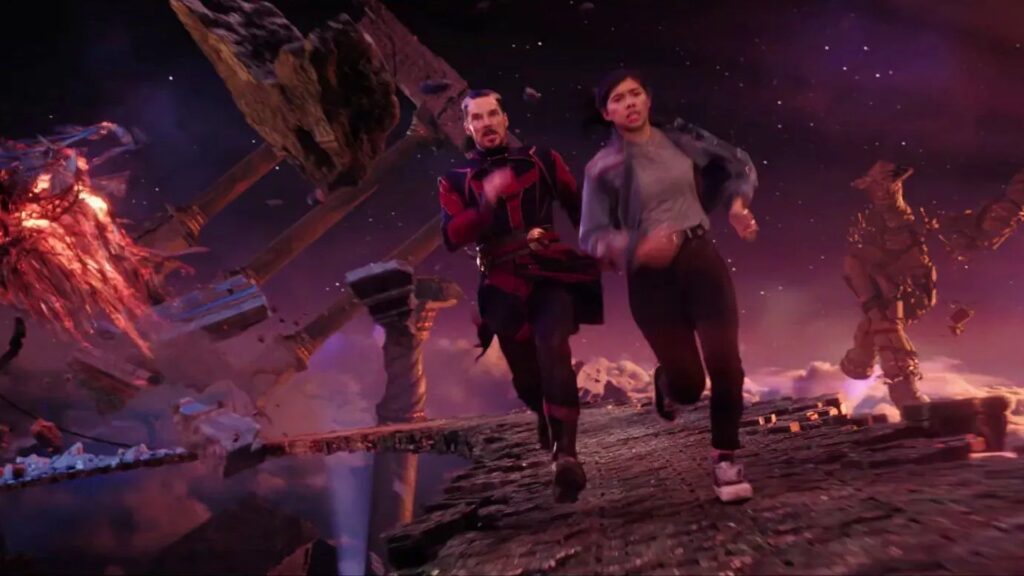
That’s the mistake the studios are making. They’re creating these big visually wild set pieces that don’t make a lick of sense. And then young writers see these and they think, “Oh, that’s the way you’re supposed to do it.” So then *they* write big awkward CGI scenes. Those scenes are then put in the next superhero movie. And it becomes a vicious circle.
Which is why nobody knows how to do this anymore.
So, for starters, when you’re trying to construct a set piece, don’t think big first. Think SMALL first. Small is much easier to understand. It will require way less geographical orientation. And it will allow you to come up with a set of simple rules that you can then play with to make your set piece as dramatic and suspenseful as possible.
Which is exactly what the CIA computer hack scene in Mission Impossible does.
It’s a tiny room. That’s our set piece. That and the vent.
Once you have your contained space, set up the rules of the set piece. In this case, the room is the most sophisticated room in Langley. It detects weight changes, sounds, even heat.
This is where the fun starts. You have these challenges, such as, we can’t walk in because it will detect our body weight. Okay, so I guess we have to suspend Ethan and lower him from above. How do we do that? Well, there’s this vent here. Okay, but how do we create a suspension system within that small space that’s going to be reliable?
Notice how even before we’ve gotten to the set piece, we’re already becoming invested in it. Nobody does that anymore. They just throw us into some wild mid-city chase with a bunch of characters we barely know.
Then, once we get to the set piece, we can continue to have fun with the rules we’ve set up. For example, if Ethan so much as touches the floor, it will trigger the weight sensor and they’ll be caught. So, one of the first things that happens is that the cords slip and Ethan falls quickly towards a collision with the floor, only to be caught at the last second.
I’ll never forget the collective gasp from the audience in my theater when that moment happened. That’s when you know you’ve created an awesome set piece.
The rules are so perfectly set up in that scene that there’s a moment where Luther has a bead of sweat that’s in danger of dropping from his nose down into the room and hitting the floor, and we’re all on the edge of our seats hoping it doesn’t happen.
Give me one Marvel set piece in 25 freaking films that achieves that. You can’t!
If you want to upgrade your set pieces, do everything I just said. But there’s one additional thing you can do to bring it to the next level: ADD AN EMOTIONAL ELEMENT – something between the characters that gives the scene a little extra oomph.
Take The Matrix for example. One of the great set pieces in that film is Neo fighting Agent Smith in the subway. Once again, contained, right? Simple, right? But, in addition to the Mission Impossible scene, we have some history between these two. Agent Smith was the bully following Neo around in the Matrix. And Neo is someone Agent Smith needs to dispose of if he’s going to execute his plan.
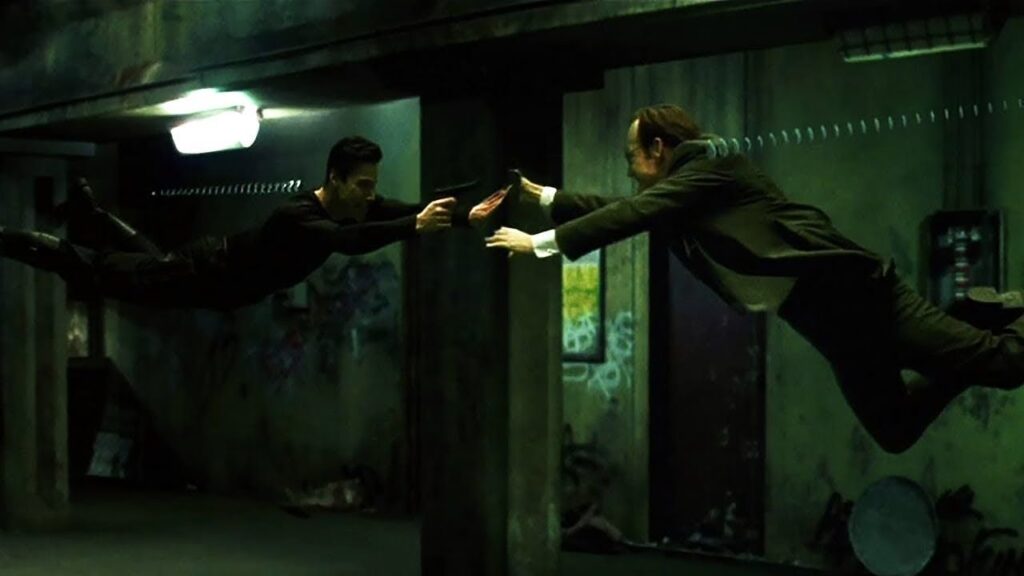
The irony here is that the Wachowskis were hoping to get Will Smith to star in The Matrix so they’d have this giant budget, which would have allowed them to write much bigger and flashier set pieces. But when they had to settle for Keanu Reeves, they had to rethink all their set pieces which made them into what I’m telling you to do here.
Contained. Simple.
The dojo fight, the lobby gunfight, even Morephues rescue is contained to an office in a skyscraper and then a helicopter right outside.
I don’t think I need to remind you what happened when the Wachowskis got all the money they wanted for the sequels. Big bombastic set pieces that didn’t hold a candle to anything that happened in the much smaller first film. If that isn’t proof that smaller more contained set pieces are better, I don’t know what is.
Getting back to Mission Impossible, a few years ago we had that well-received bathroom brawl – the one where Henry Cavill’s character and Ethan Hunt kept pummeling people who came into the club bathroom.
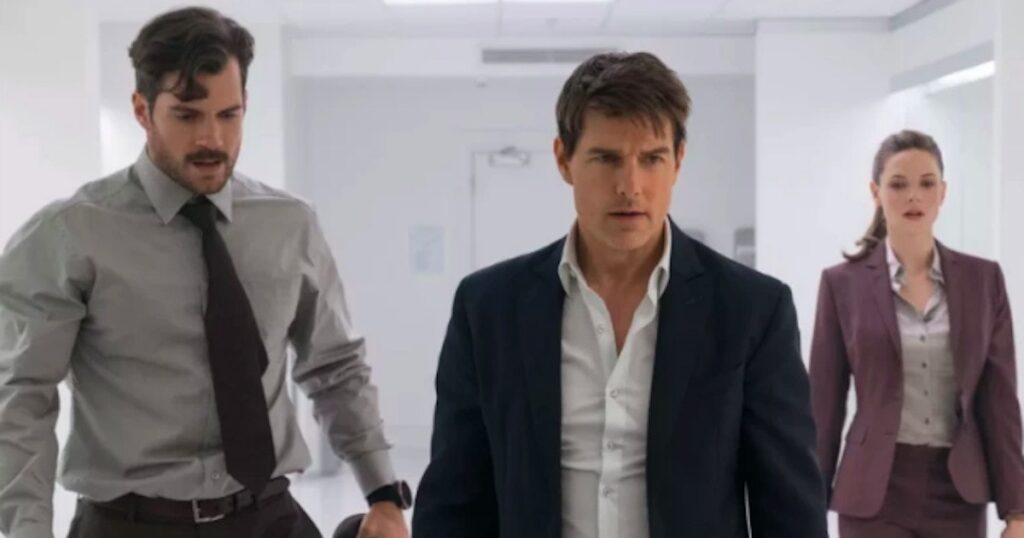
That’s a contained scene. So why isn’t it as famous as the Langley hack scene? This is your last lesson so pay attention: BECAUSE THE HACKING SCENE HAD STAKES. There was this long build-up towards it, which, on its own, created stakes. Since we had so much personal time invested in it. But even still, they needed something vital in that computer to execute the bigger plan.
The bathroom scene was fun but it was haphazard. There’s nothing truly on the line here. It’s just people beating each other up. So when you create that set piece, make sure there’s something big on the line. Or else, even the best execution of the scene isn’t going to grab the audience and shake them.
I hope writers take this to heart. It’s one of my crusades as a teacher of screenwriting. I see so many movies making this mistake and they’re just creating this garbage because of it. When it comes to set pieces, it’s always better to be think contained, to think simple, and to be clever. Only go big as a last resort.
Good luck!
